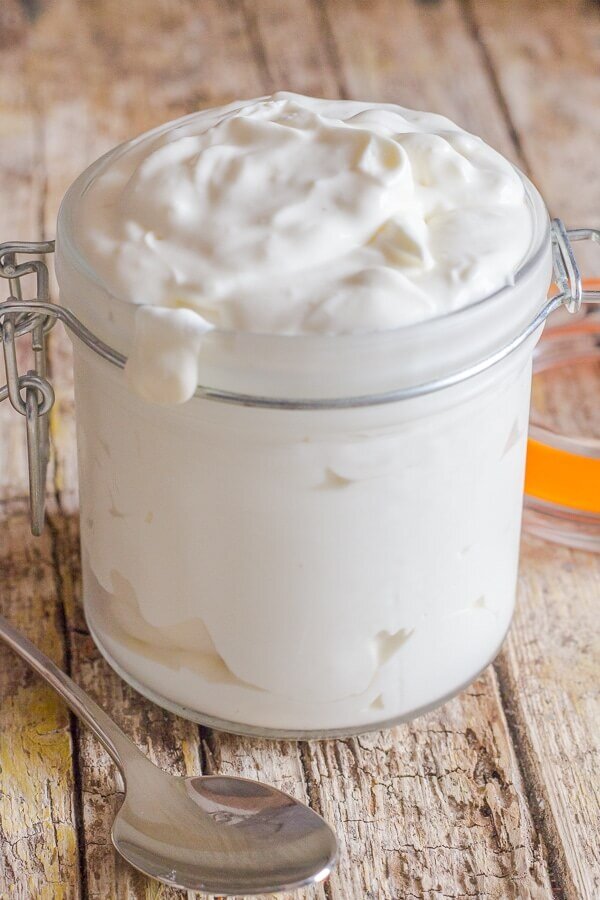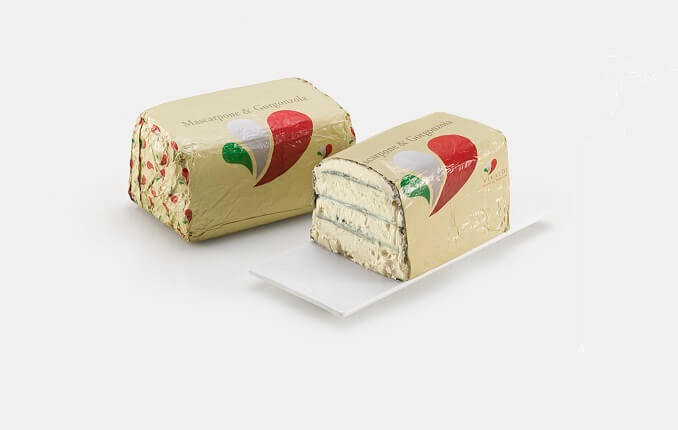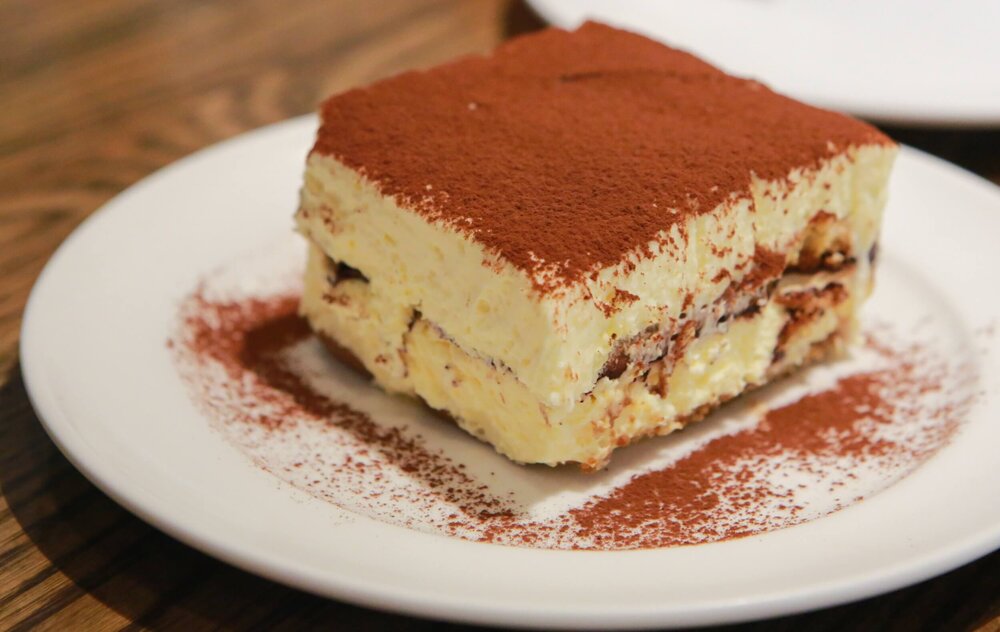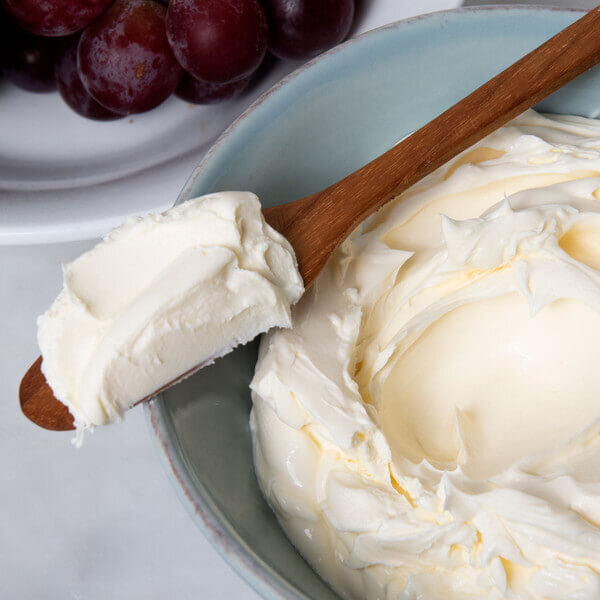Mascarpone jar courtesy of Rosemary Molloy An Italian in My Kitchen
Mascarpone is an Italian cream cheese whose rich, naturally sweet essence almost puts it in the category of dessert. It does, in fact, make up nearly half the volume of a traditional tiramisu, though it also has myriad uses in savory cooking. Before I get into the “what, where, and how of mascarpone” first things first: you may be pronouncing it wrong.
Mah-scar-PONE-eh. Note the position of the “r” at the end of the second syllable, not the first, as well as the sassy fourth Italian “eh” syllable. This is apparently enough of a controversy that its online presence is nearly dominated by the fact that English speakers, even those in the food industry, tend to incorrectly refer to the product as “MAR-sca-pone.” (I’ll save “bruschetta” for another day.)
Now that that’s sorted out, let’s get to know the enigmatic mascarpone through its history, production, and use.
Vivaldi foods Mascarpone and Gorgonzola
History of Mascarpone
Mascarpone comes from the Northern Italian region of Lombardy, an area rich in agricultural heritage also known for giving the world gorgonzola and taleggio. (Show off much, Lombardy?) A Lombardian product of layered mascarpone and gorgonzola is also available in Italy.
Believed to have originated in the late 16th or early 17th century, mascarpone has PAT designation—prodotto agroalimentare tradizionale, or “traditional agriculture food product.” This is different from the PDO designation which many Italian cheeses have—a distinction having to do with a lack of reliance on regionality. While originating in Lombardy, it can be made anywhere and still be called mascarpone. There are several ideas about its etymology, one being that mascarpone is derived from “mascarpia,” the Lombardian word for ricotta, which shares a similar production process.
How is Mascarpone Made?
Mascarpone is made through a combination of cream with heat and acid. (And a small amount of time is needed only for straining.) Similar to the creation of ricotta, a combination of precise heat and lemon juice denatures the cream, allowing for the slow straining of the liquid whey from the coagulated curd. The result is a thick, spreadable, dense cream cheese with natural sweetness.
Also like ricotta, mascarpone can easily be made at home with a handful of household ingredients and tools. Check out this recipe from cookbook creator Rosemary Molloy, author of the blog An Italian in My Kitchen.
How is Mascarpone Different from Ricotta and Cream Cheese?
The difference between mascarpone and ricotta comes down to the difference between cream and milk. Because of the fat content in the cream, mascarpone doesn’t curdle in the same way that lower-fat milk does when treated with acid. The butterfat separates from the water content and coagulates, rather than curdles. Mascarpone, therefore, achieves a rich, smooth, homogenous texture that is closer to freshly churned butter or a soft brie than the fluffy curds of its cousin ricotta.
Likewise, mascarpone differs from often-substituted cream cheese in both matters of fat content and acid. Cream cheese must only contain a butterfat content of 33 percent, whereas the fat content of mascarpone is closer to 75 percent. Cream cheese is also made with lactic acid bacteria, rather than simply acid in the form of lemon juice, and is also compressed, resulting in its dense, brick-like structure with a tangier flavor, rather than mascarpone’s smooth, loose texture and sweetness.

How is Mascarpone Used?
Because of its natural sweetness and richness, mascarpone is a staple ingredient in several Italian desserts, especially tiramisu, where it traditionally tops liqueur-soaked ladyfingers before getting a dusting of cocoa powder. For Italian-style cheesecake, mascarpone often joins forces with fluffy ricotta, for a cheesecake that is lighter and silkier than cream-cheese based American cheesecake.
In savory applications, mascarpone can be used as a thickener in risotto or soup, in frittata or other egg dishes, or as a topping for savory tarts and flatbreads. Try it in consort with other cheeses or Italian staple ingredients for a pasta sauce, as in Deborah Mele’s recipe for Pasta with Nduja, Gorgonzola Dolce, & Mascarpone.
Mascarpone photo courtesy Murray’s
Is Mascarpone Actually a Cheese?
Depending on your definition of cheese there are sometimes questions about whether unaged, uncompressed products such as ricotta and mascarpone even qualify as cheeses. In this safe cheese space, however, the versatile and delicious mascarpone certainly deserves a spot on the cheese plate.
For further reading about Italian cheeses, check out All About Ricotta, Italy’s PDO Pecorino Cheeses, and Parmigiano Reggiano vs. Parmesan: Imitating the King of All Cheeses.
